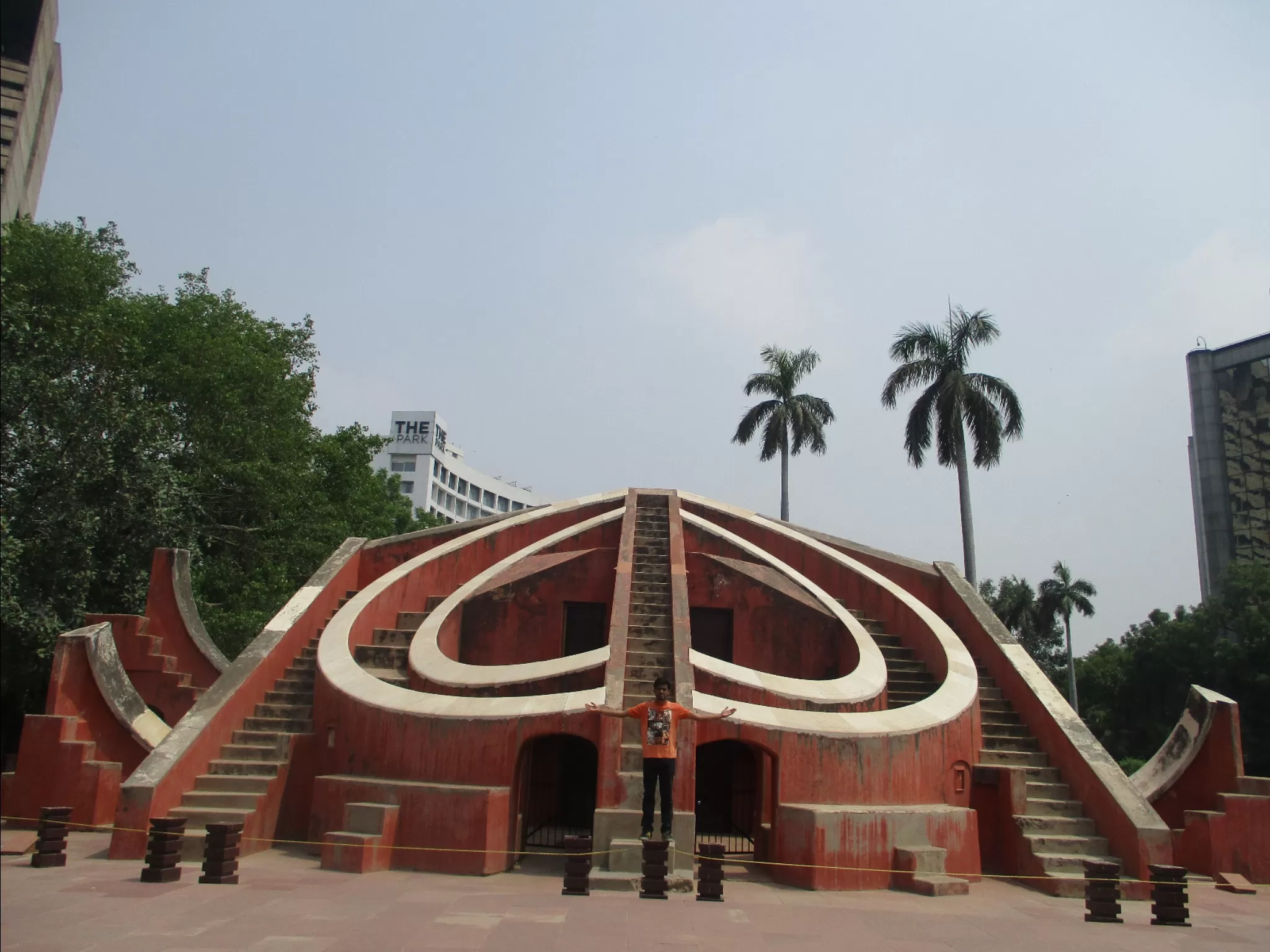Jantar Mantar Delhi is a UNESCO World Heritage Site showcasing the remarkable scientific achievements of ancient India in the field of astronomy. It was built in 1724 by Maharaja Jai Singh of Jaipur and consists of 13 architectural astronomy instruments, including the Samrat Yantra, which is a sundial and one of the most captivating structures of the observatory.
Jantar Mantar Delhi, one of the largest and oldest observatories in India, r is renowned for its distinctive architectural features, including large-scale astronomical instruments built with precision and advanced scientific knowledge for that time.
What is Jantar Mantar Delhi?

- Jantar Mantar Delhi is an astronomical observatory built by Maharaja Jai Singh II of Jaipur in the 18th century between 1724 and 1730.
- The name Jantar Mantar means "instrument for calculation" in Hindi.
- Jantar Mantar Delhi is one of the five observatories built by Maharaja Jai Singh II in India. The other four are located in Jaipur, Ujjain, Varanasi, and Mathura.
- Jantar Mantar Delhi consists of 13 structures designed to measure time, determine the positions of the sun, moon, and planets, predict eclipses, and observe the equinoxes and solstices.
- These structures are made of brick, plaster, and stone and are painted in red and yellow. They have different shapes and sizes, ranging from a giant sundial that is 27 meters high to a hemispherical instrument that is 4 meters in diameter.
- Each structure has a specific name, meaning, and function. Some of the structures are unique to Jantar Mantar Delhi and are not found in any other observatory.
- Inscribed as a UNESCO World Heritage Site in 2010, now maintained by the Archaeological Survey of India as a museum and tourist attraction
Must Read: Tourist Places to Visit in New Delhi
Structures Inside Jantar Mantar Delhi

Samrat Yantra: This is the largest structure in Jantar Mantar Delhi and is also known as the “King of Instruments”. It is a giant sundial that measures time based on the position of the sun. It has a triangular gnomon that is 27 meters high and two quadrants that are 15 meters long eachThe Samrat Yantra can also measure the declination of the sun, which is the angle between the sun and the equator.
Jai Prakash Yantra: This is a hemispherical instrument that measures the coordinates of celestial bodies. It has two concave bowls that are 4 meters in diameter each. The bowls have markings that represent the celestial coordinates. A metal rod suspended points to a celestial body and its shadow falls on the bowl. By reading the markings on the bowl, one can determine the coordinates of the celestial body.
Ram Yantra: This is a cylindrical instrument that measures the altitude and azimuth of celestial bodies. It consists of two circular walls that are 5 meters high and 11 meters in diameter each. The metal ring points to a celestial body and its shadow falls on the wall. By reading the markings on the wall, one can measure the altitude and azimuth of the celestial body.
Misra Yantra: This is a composite instrument that consists of five smaller instruments. It was added by Maharaja Madho Singh II of Jaipur in 1850. The five instruments are:
Dakshinottara Bhitti Yantra: This is a wall instrument that measures the meridian altitude of celestial bodies.
Niyat Chakra: This is a circular instrument that measures whether a celestial body is in the northern or southern hemisphere.
Krantivritta Yantra: This is a circular instrument that measures whether a celestial body is in ascension or declination.
Raj Yantra: This is an instrument that measures local time.
Shastansh Yantra: This is an instrument that measures one-sixtieth part (one degree) of an arc.
Other Structures Inside Jantar Mantar Delhi

Narivalaya Yantra: This is an instrument that measures the local time in different seasons.
Rashivalaya Yantra: This is an instrument that measures the zodiac signs of celestial bodies.
Digyansa Yantra: This is an instrument that measures the azimuth of celestial bodies.
Chakra Yantra: This is an instrument that measures the declination of celestial bodies.
Kapali Yantra: This is an instrument that measures the coordinates of celestial bodies in a stereographic projection.
Laghu Samrat Yantra: This is a smaller version of the Samrat Yantra that measures time with less accuracy.
Unnatasha Yantra: This is an instrument that measures the meridian altitude of celestial bodies at different latitudes.
Dhruva Darshak Pattika: This is an instrument that locates the pole star.
Want to explore shopping in Delhi? What are you waiting for?
Opening Hours & Entry Fees Of Jantar Mantar

Opening Hours:
Jantar Mantar is open to visitors every day from 9:00 AM to 5:00 PM.
Entry Fees:
For Indian Visitors: The entry fee is Rs. 5 per person.
For Foreign Visitors: The entry fee is Rs. 100 per person.
Guided tours are available at an additional cost for those interested in learning more about the site's history and significance.
Places To Visit Near Jantar Mantar Delhi

Connaught Place: (Less than 1 kilometer) Connaught Place, or CP, is a bustling commercial and cultural hub in the heart of Delhi. It's known for its colonial architecture, vibrant street markets, upscale shops, and a wide range of restaurants and cafes offering diverse cuisines.
India Gate: (3 kilometers) India Gate is a majestic war memorial dedicated to the soldiers of the Indian Army who died in World War I. It's an iconic landmark and a popular spot for picnics and evening strolls, offering a glimpse into India's history and patriotism.
National Museum: (2 kilometers) The National Museum is a treasure trove of Indian art, culture, and heritage. It houses a vast collection of artifacts, including sculptures, paintings, manuscripts, and archaeological finds, showcasing the rich history and diversity of India.
Janpath Market: (Less than 1 kilometer) Janpath Market is a vibrant shopping destination known for its eclectic mix of shops selling clothing, handicrafts, jewelry, and home decor items. It's a great place to shop for souvenirs and immerse yourself in Delhi's bustling street life.
Palika Bazaar: (Less than 1 kilometer) Palika Bazaar is an underground market known for its wide range of shops selling electronics, clothing, accessories, and more. It's a popular destination for bargain hunters and those looking for affordable shopping options.
Must Read: Street Markets in Delhi You Must Visit
How To Reach Jantar Mantar Delhi

By Metro: The nearest metro station to Jantar Mantar is Rajiv Chowk, which is on the Yellow Line and the Blue Line of the Delhi Metro. From Rajiv Chowk, Jantar Mantar is a short walk away.
By Bus: Several buses ply to Jantar Mantar from different parts of Delhi. Buses going towards Connaught Place or Central Secretariat are likely to pass by Jantar Mantar.
By Car: If you're driving, you can reach Jantar Mantar via Sansad Marg or Ashoka Road. However, parking may be limited in the area, so it's advisable to use public transport.
Tips For Visiting Jantar Mantar Delhi

- The best time to visit Jantar Mantar Delhi is between November and February, when the weather is pleasant and clear. You can avoid the scorching heat, humidity, dust, and pollution of summer and monsoon seasons.
- The time required to visit Jantar Mantar Delhi is around 2 hours. You can explore the structures at your own pace and learn about their functions and features. You can also take pictures and videos of the instruments.
- The restricted items for Jantar Mantar Delhi are weapons, explosives, flammable materials, alcohol, drugs, pets, bicycles, skateboards, rollerblades, drones, large backpacks, tripods etc. You can deposit these items at the locker facility near the entrance gate.
- Climbing on the structures or touching the instruments is not permitted to ensure their preservation.
Also Read: Jantar Mantar in Delhi - Reliving the pride of ancient Science in India

















































